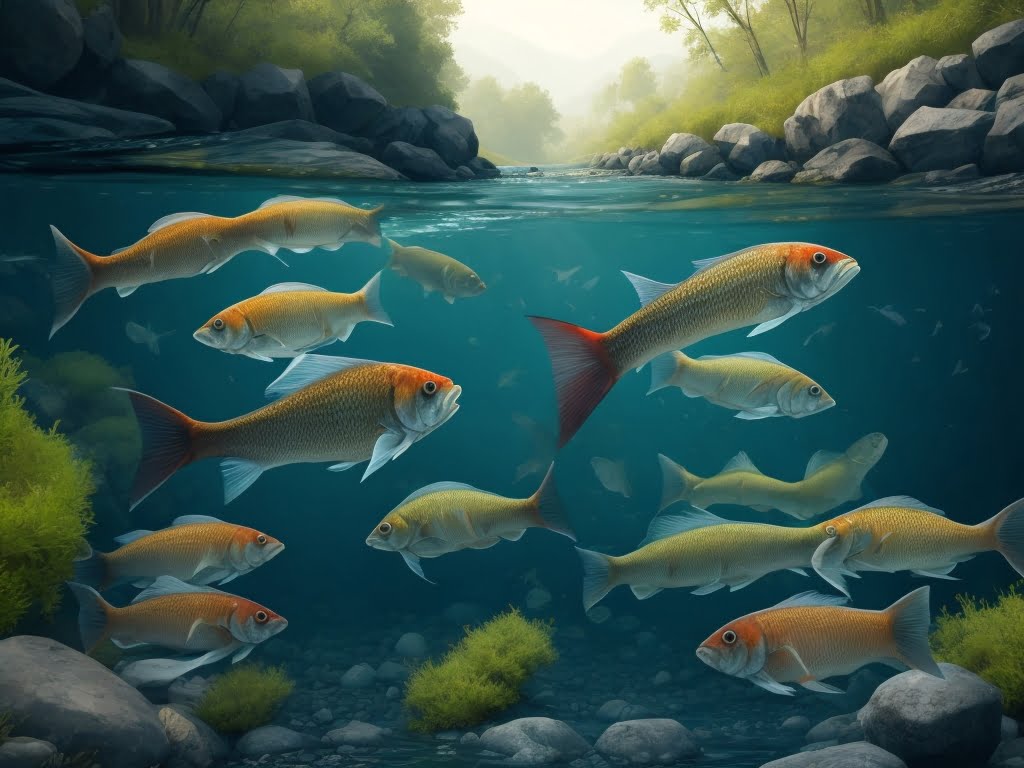Canal System in Porifera: The canal system is a unique feature found in the phylum Porifera, commonly known as sponges. Porifera is a group of multicellular organisms that lack true tissues and organs but possess specialized cells to perform various functions.
The canal system in porifera is responsible for water circulation, food capture, and waste removal. It helps maintain a constant flow of water through the sponge’s body, allowing them to filter feed and obtain nutrients.
The basic structure of a sponge consists of a hollow, cylindrical body with two main layers: the outer layer called the ectoderm and the inner layer called the endoderm. These layers enclose a jelly-like substance known as mesohyl or mesenchyme, which contains various types of cells, including choanocytes and porocytes.
The canal system of a sponge can be classified into three main types: asconoid, syconoid, and leuconoid. Each type represents a different level of complexity and efficiency in water flow and filtration.
Canal System in Porifera
Asconoid Canal System:
It is a simplest type of canal system and is found in some simple, thin-walled calareous sponges (order Homocoela) – e.g. adult Leucosolenia and the Olynthus or Ascetta stage of Clathrina. Ostia or inhalant pores, each intracellular in a porocyte, lead directly (since the body wall is very thin) into the spongocoel or paragastric cavity, which is lined by flagellated choanocytes or collar cells. Spongocoel opens to the outside
through a narrow circular osculum located at the distal free end of the sponge body and is often fringed with large monaxon spicules. ‘Canal System in Porifera’
Water enters through ostia into spongocoel and goes out of the body through the osculum. The current flow is maintained by the beating (nonsynchronous) of the flagella of choanoctes. In certain thick-walled homocoelan, ostia lead into radial canals that open via apopyles into the spongocoel. Both spongocoel and radial canals are lined by choanocytes.
Asconoid structure imposes limitations so the size of such sponges is always small. The flow of water is also slow because the large spongocoel contains much water which cannot be pushed out readily through the single osculum. Complex forms (syconoid) have evolved by increasing surface to volume ratio as a result of thickening and folding up of the body wall.
The course of water current is as follows:

Syconoid Canal System:
In syconoid sponges (order Heterocoela), e.g. Scypha and Grantia, Euplectella – theoretically derived from the asconoid structure by the out pushing of the body wall into blind finger-like diverticula (radial canals or flagellated chambers) at regular intervals. Between them lie incurrent canals, blind at inner edge and lined with ectodermal pinacocytes (as they represent the original outer surface of the asconoid sponge). Water comes into it via incurrent pores or ostia and goes into the radial canals via minute pores called prosopyles. The dermal ostia or (incurrent) dermal pores are intercellular (perforating a pore membrane). Ostia are bounded by contractile myocytes and guarded by projecting oxeas. Prosopyles are intercellular and correspond to the intracellular inhalant pores of the Olynthus. Each radial canal opens into the spongocoel by an opening called apopyle. Spongocoel is narrow and lined by pinacocytes and opens to exterior through the osculum. – Syconoids differ from asconoids in having thick folded walls with alternating radial and incurrent canals, and the choanocytes or flagellated cells limited to the radial canals. Radial symmetry has been retained.
(i) Simple sycon type: – In the simplest Heterocoela eg Sycetta. – The radial canals are free projections, without touching at any point. Hence outside water surrounds their whole length. The incurrent canals have not definitely formed.
(ii) Complex sycon type: – in Scypha (= Sycon) – Walls of adjacent radial canals are arranged (fused) in such a way as to leave (enclose) between them tubular (definite canal-like) spaces, called the incurrent or inhalant canals. – Radial canal opens by a wide aperture, called apopyle, into a short wide ex-current or exhalent canal which communicates with the spongocoel by a very wide gastric or internal ostium. Finally, the spongocoel opens to the exterior by osculum. ‘Canal System in Porifera’
(iii) Sycon type with cortex: – in Grantia, Grantiopsis, Heteropia, Ute, etc. – A dermal membrane (epidermis plus a thin layer of mesenchyme) spread over the entire surface of the sponge to form the cortex of variable thickness. Mesenchyme also accumulates in the wall of the spongocoel forming the gastral cortex. With the development of cortex, sometimes, the incurrent canals become irregular, branching and anastomosing, and may form large irregular cortical spaces or sub-dermal spaces.

Leuconoid Canal System:
The leuconoid canal system is the most complex and efficient among the three types. It is found in larger and more complex sponge species, including many commercially valuable sponges. In this system, the body wall is highly folded, forming a complex network of chambers and canals. It consists of multiple
interconnected chambers known as flagellated chambers or choanocyte chambers. These chambers are lined with choanocytes, which create water currents and capture food particles. Water enters through numerous small incurrent canals, regulated by porocytes. From the incurrent canals, water is directed into the flagellated chambers, where filtration and feeding take place. Water then passes through excurrent canals and exits the sponge through a larger osculum.
The canal system in poriferans is a specialized network of canals and chambers that facilitate water circulation, filtration, and feeding. It allows sponges to efficiently capture food particles suspended in the water and remove waste products. The complexity of the canal system varies among different sponge species, with the leuconoid system being the most advanced and efficient.

Leucon type can be classified into the following types:
Euryphylous: The flagellated chambers communicate directly by broad apopyles with the excurrent canals, and by the prosopyles with the incurrent canals. The leuconoid Calcarea always remain at the euryphylous stage. In Demospongiae, it is attained from rhagon stage by way of spongophare outfoldings. It may be: Simple euryphylous – Plakina Complex euryphylous – A dermal membrane (like dermal cortex of Calcarea) spreads over the openings of the incurrent sinuses. The outer part of sponge body, including the cortex and the subdermal cavities, is termed ectosome while remaining inner region is choanosome. Eg Plakortis, Tetilla

Aphodal: The apopyle is drawn out as a narrow canal, called aphodus, between the flagellated chamber and excurrent canal. E.g. Geodia. Stellata
Diplodal: Besides aphodus, another narrow tube, called prosodus, is present between incurrent canal and flagellated chamber. E.g., Oscarella (), Spongilla (rhagon type of diplodal leuconoid) and Chondrosia, Corticium

Rhagon Type of canal system
In calcareous sponges, leuconoid structures may arise by way of asconoid and syconoid stages or directly from asconoid stage (Leucilla, Leucandra). But in non-calcareous sponges or Demospongiae, the leuconoid condition is derived from a larval stage called the rhagon (not found in adults); hence leucon type is sometimes also termed the rhagon type. The rhagon body is a conical pyramid having a flagellated-chamberless broad base (hypophare) and the upper walls (spongophare) with a row of flagellated
chambers, tapering towards the osculum – bearing apex. Mesenchyme is considerably thick and is traversed by subdermal cavities and incurrent canals. Dermal pores or prosopyles lead into the flagellated chambers which open into the central spongocoel by very wide apopyles.
Functions of the Canal System
The canal system in Porifera serves several vital functions essential for the survival and functioning of the sponge.
Water Circulation
The canal system enables the continuous circulation of water through the sponge’s body. Water enters through the incurrent canals, flows through the radial canals, and exits through the excurrent canals and oscula. This constant flow ensures the availability of oxygen, nutrients, and the removal of waste products.
Feeding Mechanism
The canal system plays a crucial role in the feeding mechanism of Porifera. Water currents generated by the beating of choanocyte flagella bring in microscopic food particles and microorganisms. Choanocytes capture these particles using their specialized structures and ingest them for nourishment.
Respiration and Gas Exchange
Respiration in Porifera occurs through the process of diffusion. As water flows through the canal system, oxygen from the surrounding water diffuses into the sponge’s cells, while carbon dioxide, a waste product, diffuses out into the water.
Waste Elimination
The canal system also facilitates the removal of metabolic waste products from the sponge’s body. Waste particles diffuse out of the cells and are carried away by the water flowing through the canals. Eventually, they are expelled through the oscula.
Adaptations of the Canal System
The canal system in Porifera exhibits remarkable adaptations that enhance the sponge’s survival in its environment. The extensive branching of canals increases the surface area available for water flow, maximizing nutrient absorption and gas exchange. The beating of choanocyte flagella generates water currents, ensuring efficient feeding and waste removal.
Importance of the Canal System in Porifera
The canal system is vital for the survival of Porifera. It enables the sponge to obtain nutrients, respire, eliminate waste, and reproduce. Without the canal system, Porifera would be unable to carry out these essential functions, compromising its survival and growth.
Conclusion
The canal system in Porifera is a remarkable feat of biological engineering. Its intricate network of canals facilitates vital processes such as feeding, respiration, waste elimination, and reproduction. Through the regulated flow of water, Porifera ensures its survival and success in the marine ecosystem.





